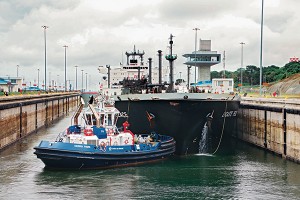More propane transiting expanded Panama Canal

The Panama Canal expansion allows propane shipments from the U.S. Gulf Coast to reach destinations in Asia more easily and efficiently. Photo courtesy of the Panama Canal Authority.
The flow of hydrocarbon gas liquids (HGL), especially propane, through the Panama Canal from the U.S. Gulf Coast to Asia has increased since the Panama Canal Authority opened a third set of locks that facilitated transit of larger ships in 2016. This marked the first expansion of the canal since its completion in 1914.
The U.S. Energy Information Administration highlighted the impact of the expansion in an April report.
Most of the petroleum transiting the Panama Canal travels south from the Atlantic Ocean to the Pacific Ocean. HGLs are the largest single petroleum commodity transiting the canal, according to data from the Panama Canal Authority. In 2018, about 387,000 barrels per day (bpd) of HGLs moved southbound through the canal, compared to 266,000 bpd of distillate and 230,000 bpd of motor gasoline.
Before 2016, the main constraint for increasing U.S. HGL exports was export infrastructure on the U.S. Gulf Coast. By 2016, the addition of Gulf Coast infrastructure alleviated this constraint. The size limits of the original Panama Canal locks, and the costs associated with alternative shipping routes, became the main constraints for increased exports.
The most economical way of transporting large volumes of HGLs by water is with very large gas carriers (VLGC). The shortest route from the U.S. Gulf Coast (where most U.S. HGL export capacity is located) to Asia (the largest destination for U.S. exports) is through the Panama Canal. However, the original set of Panama Canal locks were too small to allow most VLGCs to transit.
After the canal’s expansion, VLGCs can now transit the canal. The growth in HGLs transiting the Panama Canal coincided with an increase in exports of HGLs from the U.S. Gulf Coast to destinations mostly in Asia. In 2018, four of the five largest destinations for these exports were in Asia. Export data shows the destinations but does not provide information about the route.
















